From the dark, damp corners of your backyard to the deep recesses of forests, ticks thrive in a variety of environments. With their ability to transmit diseases such as Lyme disease, babesiosis, and anaplasmosis, it is crucial to grasp the underlying reasons behind their affinity for human hosts. By understanding the factors that attract ticks to humans, we can adopt proactive measures to minimize encounters and mitigate the potential health hazards they pose. And so the question remains: “Why do ticks bite humans?”
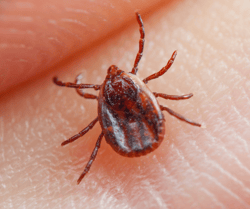
What are ticks? Biology, Behavior, and Beyond.
Ticks are actually small arachnids belonging to the order Ixodida, known for their parasitic lifestyle. Despite their minuscule size, ticks possess complex biology and exhibit fascinating behavioral patterns. These parasites are widely distributed across the globe, thriving in diverse habitats ranging from wooded areas to grasslands. Ticks are prevalent throughout the United States, though less so in extremely cold regions such as Alaska.
There are thousands of tick species identified worldwide, with over 900 species classified to date. In terms of appearance, ticks can vary in size and color depending on their life stage and species. Generally, adult ticks have a rounded or oval-shaped body that becomes engorged and swollen after feeding. Their size can range from as small as a pinhead (in the case of larvae) to around the size of a sesame seed (nymphs) and even larger when fully engorged females feed.
The body of a tick consists of two main regions: the capitulum (head) and the idiosoma (body). The capitulum is positioned at the front of the tick and contains mouthparts used for feeding. These mouthparts include piercing structures, such as chelicerae and a hypostome, which allow the tick to attach to the host and extract blood. Ticks have eight legs, with the larvae and nymphs having six legs initially, and the adult ticks having all eight legs. The legs are equipped with tiny claws that help the tick to grip onto surfaces, including the host's skin.
The coloration of ticks can vary, but they often have a reddish-brown or dark-brown hue. However, the color may change depending on factors such as feeding status, species, and the presence of blood in their digestive system. It's important to note that tick species can exhibit variations in appearance, size, and other characteristics. Identifying ticks accurately often requires careful examination and knowledge of specific distinguishing features.
Ticks are hematophagous parasites, meaning they feed exclusively on blood. They have highly developed mouthparts designed for piercing the host's skin and extracting blood. While feeding, ticks secrete saliva that contains anticoagulant compounds, allowing them to obtain a continuous blood supply without interruption. This saliva may also contain disease-causing pathogens, which can be transmitted to the host during the feeding process, making ticks a significant vector for various illnesses, including Lyme disease, Rocky Mountain spotted fever, and tick-borne encephalitis.
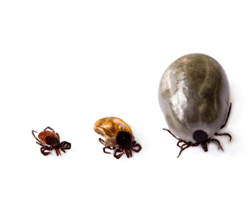 Different ticks in varying stages of engorgement.
Different ticks in varying stages of engorgement.
Do ticks need blood to survive?
Unfortunately, yes.
Ticks require blood meals to survive and complete their life cycle. Blood serves as the primary source of nutrition for ticks, providing essential nutrients and energy for their growth, development, and reproduction. While some ticks can survive for extended periods without feeding, they eventually need to obtain blood in order to thrive and reproduce successfully.
Ticks go through multiple stages in their life cycle: egg, larva, nymph, and adult. Each stage, except for the egg stage, requires a blood meal to progress to the next. After hatching from eggs, the larvae actively seek their first blood meal. Once they have fed and engorged themselves, they molt into nymphs. Nymphs then feed on a second blood meal to fuel their development into adult ticks.
For adult female ticks, blood is particularly crucial as it provides the necessary nutrients for egg production. After feeding, engorged females drop off their hosts and lay thousands of eggs, beginning a new generation of ticks.
It's worth noting that not all tick species feed on human blood. Some ticks have specific preferences for particular animal hosts, such as rodents, birds, or larger mammals. However, when their preferred hosts are scarce, ticks may opportunistically feed on humans or other available hosts.
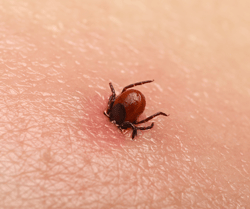 Tick buried in human skin.
Tick buried in human skin.
Why are ticks attracted to humans?
Ticks are attracted to humans for several reasons, and their feeding behavior on humans can be attributed to various factors:
- Heat and Body Odor: Ticks are highly sensitive to heat and can detect the warmth emitted by humans. Our bodies also produce certain odors that are attractive to ticks. These odors, which can vary among individuals, serve as cues for ticks to locate potential hosts.
- Carbon Dioxide: Ticks can sense the carbon dioxide exhaled by humans. The release of carbon dioxide signals the presence of a nearby warm-blooded host, attracting ticks to their vicinity.
- Movement and Vibrations: Ticks are responsive to movement and vibrations. When humans or animals pass by, the movement and vibrations can trigger a tick's “questing” behavior. They may climb up vegetation or perch on surfaces, waiting to latch onto a passing host.
- Visual Attraction: While ticks primarily rely on other sensory cues, they may also be visually attracted to contrasting colors or patterns on clothing or exposed skin.
- Chemical Signals: Ticks can detect specific chemicals emitted by mammals, including humans. These chemical signals, such as certain pheromones, may guide ticks toward potential hosts.
Once a tick identifies a human as a suitable host, it uses its specialized mouthparts to pierce the skin and feed on blood. Ticks require a blood meal to obtain essential nutrients, particularly proteins, that are vital for their growth, development, and reproduction.
 Ticks may climb up vegetation or perch on surfaces, waiting to latch onto a passing host.
Ticks may climb up vegetation or perch on surfaces, waiting to latch onto a passing host.
Are ticks harmful to humans and pets?
As you may have guessed, ticks can pose significant health risks to both humans and pets. Because they are ectoparasites, ticks feed on the blood of their hosts, and during this feeding process, they can transmit various pathogens that cause diseases. Some of the diseases transmitted by ticks include:
- Lyme Disease: Lyme disease is caused by the bacterium Borrelia burgdorferi and is primarily transmitted by black-legged ticks (also known as deer ticks). Symptoms may range from mild to severe.
- Rocky Mountain Spotted Fever: This is a bacterial infection transmitted by ticks, particularly the American dog tick and the Rocky Mountain wood tick. Symptoms may range from mild to severe.
- Ehrlichiosis: Ehrlichiosis is a bacterial infection transmitted by ticks, such as the lone star tick and the brown dog tick. Symptoms may range from mild to severe.
- Anaplasmosis: Anaplasmosis is another bacterial infection transmitted by ticks, including the black-legged tick and the western black-legged tick. Symptoms may range from mild to severe.
- Babesiosis: Babesiosis is caused by parasites that infect red blood cells and is transmitted by ticks, such as the black-legged tick and the brown dog tick. Symptoms may range from mild to severe.
These are just a few examples of the diseases that ticks can transmit. It is essential to be aware of the potential risks associated with tick bites and to take preventive measures when spending time in tick-prone areas. If you or your pet have been bitten by a tick and experience concerning symptoms, it is recommended to seek medical or veterinary attention for proper diagnosis and treatment.
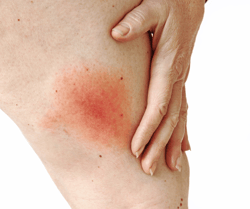 Lyme disease is caused by Borrelia burgdorferi and is primarily transmitted by black-legged ticks.
Lyme disease is caused by Borrelia burgdorferi and is primarily transmitted by black-legged ticks.
How can I prevent tick bites?
Understandably, you may want to try and prevent tick bites on you and your loved ones. While eliminating the potential for tick bites entirely is impossible, there are several measures you can take to reduce the presence of ticks and prevent bites:
- Maintain a Tidy Yard: Keep your yard well-maintained by regularly mowing the grass, trimming vegetation, and removing leaf litter. Ticks thrive in tall grasses and dense vegetation, so creating a less tick-friendly environment can help reduce their populations.
- Create a Barrier: Consider creating a physical barrier between your yard and tick-infested areas, such as wooded areas or tall grassy fields. This can be done by installing a fence or using landscaping techniques to create a clear space.
- Remove Tick Habitat: Eliminate or reduce potential tick habitats in your yard, such as woodpiles, leaf piles, and overgrown shrubs. Ticks prefer dark and humid environments, so reducing these favorable conditions can deter them.
- Create a Tick-Free Zone: Establish a designated play or recreation area in your yard that is treated to be tick-free. This can involve regularly applying tick control products, such as acaricides or insecticides, to the designated area. We recommend contacting an expert pest prevention specialist or company to assist, especially if you have children or pets.
- Apply Yard Treatments: Consider using tick control treatments designed for yards and outdoor spaces. These treatments can help reduce tick populations by targeting ticks at various stages of their life cycle. We recommend contacting an expert pest prevention specialist or company to assist, especially if you have children or pets.
- Keep Wildlife Away: Discourage wildlife, such as deer, rodents, and birds, from entering your yard as they can carry ticks. Install fencing to deter deer and make your yard less attractive to other wildlife by removing potential food sources like bird feeders.
- Dress Protectively: When spending time in tick-prone areas of your yard, wear long-sleeved shirts, long pants, and closed-toe shoes. Tuck your pants into socks and wear light-colored clothing to make ticks more visible.
- Use Insect Repellent: Apply an EPA-approved insect repellent containing DEET, picaridin, or permethrin to exposed skin and clothing. Follow the instructions on the product label for safe and effective use.
- Perform Regular Tick Checks: After spending time outdoors, thoroughly check your body, clothing, and pets for ticks. Pay close attention to areas such as the scalp, neck, armpits, groin, and behind the ears. Promptly remove any ticks you find using tweezers or a tick removal tool.
By implementing these preventive measures, you can significantly reduce the likelihood of being bitten by ticks in your yard. Remember to stay vigilant and consistently follow these practices, especially during peak tick season.
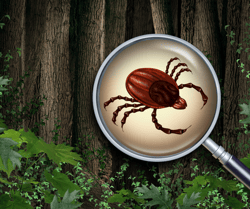 Ticks prefer dark and humid environments, so reducing these favorable conditions can deter them.
Ticks prefer dark and humid environments, so reducing these favorable conditions can deter them.
Can EcoShield help prevent ticks in my yard?
Yes!
EcoShield’s holistic residential services can assist in preventing ticks in your yard. Our expert pest technicians will thoroughly inspect your yard for potential tick hot spots, provide customized recommendations for tick population reduction, and offer continuous monitoring and maintenance to ensure populations remain controlled. At EcoShield, we believe that prevention is the most effective and affordable pest management tool. If you’re concerned about ticks in your yard, give EcoShield a call or fill out the form on this page today for a free no-obligation quote.